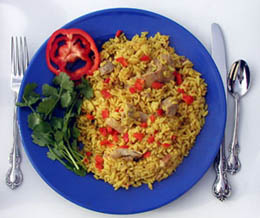Jorge Castillo: The Chinese may have brought rice to Spain in the 15th or 16th Century.
Glenn Lindgren: If they did, they were a little late to the party. The Arabs actually introduced rice to Spain in the 8th or 9th century.
Jorge Castillo: This according to one of our readers, David Wilmsen, Associate Professor of Arabic at The American University of Beirut!
Raúl Musibay: According to David, “the Arabs got the rice from the Persians. One sure indicator that Arabs brought rice to Spain is that the Spanish word for rice sounds almost exactly like the Arabic: ar-ruz -- even the r-r is rolled. Not only that, but the word 'paella' comes from the Arabic word for leftovers ba'aaya.”
Jorge Castillo: The Spanish people created many dishes that combine rice with seafood, meat, poultry, and sausages to create delicious dishes, such as arroz con pollo, paella, and mariscada.
Glenn Lindgren: All these recipes combine rice with wine, olive oil and spices to give it a wonderful aroma and delicious flavor. The Spanish colonization of Cuba introduced these culinary creations to Cuba later in the 16th century.
Jorge Castillo: The Cubans added tomato and garlic to these recipes, giving them a more "Cuban" touch. Arroz con Pollo is easy to prepare, and very economical to make. Some of the best dishes include beer -- it gives it a great flavor.
Glenn Lindgren: Arroz con pollo is enjoyed by many Latin cultures. The Cuban version is highly spiced -- but NOT spicy hot. It's a favorite Cuban Sunday lunch dish.
Raúl Musibay: In fact, this recipe had its origin in a recipe sent to us by an American lady who had fond memories of Cuban meals with her friend's family.
Glenn Lindgren: The Three Guys have done some tinkering with this recipe over the years. We've made a few changes here and there and we think it tastes better than ever!







